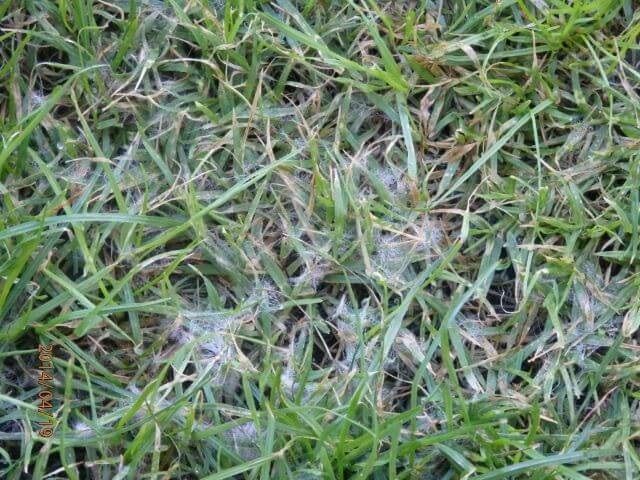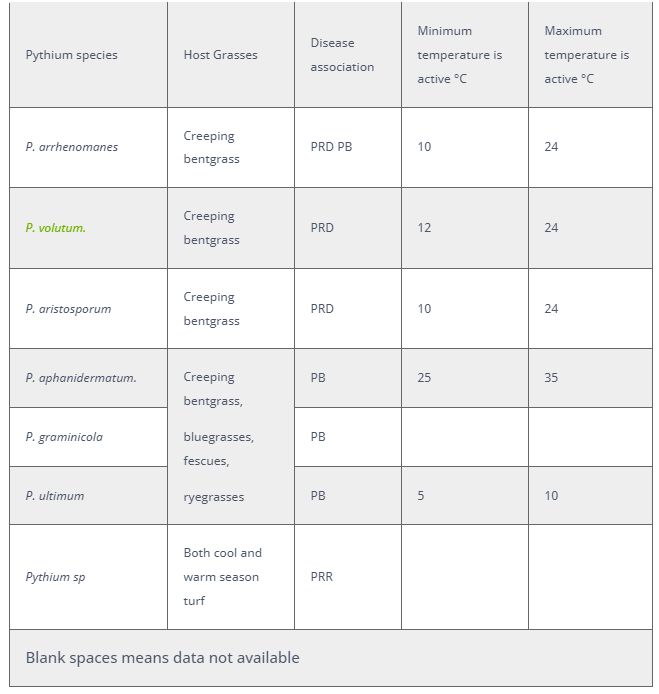There are several Pythium sp that cause Pythium in turf. This turfgrass blog discusses pythium fungus in grass, what these are and how to identify and control them. Pythium in turfgrass can rear its head as pythium blight, pythium root rot, and damping off.
The problem is that Australian testing laboratories only tend to diagnose the Pythium fungus in grass as “Pythium sp” when in fact you could be dealing with Pythium root rot, Pythium blight, Pythium root dysfunction, or damping off. Diagnosing the disease simply as Pythium sp is oversimplifying the management of this disease. To make the correct pythium fungicide choice1Hampy, H.D., Van Ryzin, B.J., Butler, E.L., Kerns, J.P., Etiology and management of Pythium root rot in golf course putting greens, Int Turfgrass Soc Res J.2022;14:851–860 it is important to know which Pythium root disease and corresponding species are present.
- Not all Pythium fungicides and turf-registered fungicides work equally well against all pythium in turf. This is the case in both the home garden and professional turf;
- Incorrect disease identification can waste both your time and money.
Pythium spp.
Damping off.
This is a Pythium disease in turf at the seedling stage of sports turf seed. If conditions such as excess moisture, the right temperature, and poor light conditions are present, seed damping-off becomes more likely.
Pythium in turf
Pythium Root Rot (PRR)
A complication of pythium root rot diagnosis is that there are two different Pythium root diseases. These are Pythium Root Rot (PRR) and Pythium Root dysfunction (PRD). These have distinct differences between them that impact their management.
- Favours wet soils;
- Pythium root rot affects all turfgrasses;
- Is more common on high organic matter content or poorly draining soils.
- Commonly associated with frequently and closely mown intensively managed turf.
Root death and a rotting smell are symptoms of this pythium fungus in grass and this disease develops in association with high soil moisture and temperature. The fact that temperature impacts the organisms that are causing this disease goes some way to explaining why you can get such variability when carrying out chemical control.
Conditions favouring Pythium Root Rot.
- This tends to develop on cool-season putting greens, during summer months when soils are warm and wet.
- On warm-season turf the disease is most severe under low-light conditions, especially during the autumn, winter, and spring.
- Tends to occur in areas where water pools but can affect higher areas after rainfall.
- Greens with little air movement that are shaded for long periods are most susceptible to this. High-capacity air-circulating fans to enhance air circulation, and promote surface drying;
- Symptoms can continue to develop new spots or continue to expand as long as soils are warm and wet.
- increased infection by Pythium species when in the presence of sting or root-knot nematode 2Gu, M., Bermudagrass root rot complexes associated with plant parasitic nematodes and pythium species on golf courses in Florida, May 2019, Abstract of Dissertation Presented to the Graduate School of the University of Florida in Partial Fulfillment of the Requirements for the Degree of Doctor of Philosophy.
Cultural control of Pythium root rot.
- Reduce plant stress;
- Improve light penetration and air movement;
- Avoid over-fertilizing with nitrogen;
- Improve soil drainage by carrying out soil aeration;
- Increase the height of cut;
- Carry out a program of regular topdressing and aerating. This will improve water movement away from the surface.
Chemical Control of Pythium Root Rot
- Segway provides the best control of this species of this Pythium in turfgrass;
- After this in decreasing effectiveness look at fosetyl-Aluminium, then mefonaxam, and finally propamocarb;
- Etridiazole is effective3Kerns, J.P., Pythium in golf course putting greens, Golf Dom, November 23, 2021, but you only get a residual of three to four days;
- Follow a fungicide resistance management program;
- For cool-season grass putting greens, start with Segway at 2.5L/Ha once soil temperatures reach 18°C at a 50mm depth for four to five consecutive days in the spring.
- A rotation of Segway, Solitaire, and Shrapnel on two-week intervals works well with all PRR applications making sure they are watered in with 3mm of water.
- Preventative foliar applications of Grenadier also work well.
Pythium in turf
Pythium Root Dysfunction (PRD).
This is a very different pythium fungus in grass compared to Pythium root rot. Pythium root dysfunction symptoms don’t include root necrosis which means it is much more difficult to identify. Because Pythium volutum is a root-rotting pathogen, it affects the ability of creeping bentgrass to take up water. This means that when soil and surface temperatures are high, turf looks wilted and eventually dies.
Traditional Pythium fungicides do not control Pythium root dysfunction, so instead you should use the QoIs (azoxystrobin, pyraclostrobin) and cyazofamid as these are the most effective. A standalone pyraclostrobin isn’t registered in Australia so your best alternative is Lexicon Intrinsic fungicide. You must make preventative applications of Pythium root dysfunction fungicides in the autumn and spring during the infection period, well before symptoms occur.
Symptoms of Pythium Root Dysfunction.
- The disease only occurs on creeping bentgrass and is worst on newly constructed putting greens, specifically those with rootzones of 85 % sand4Kerns, J.P., Soika, M.D., and Tredway, L.P., 2009. Preventative control of Pythium root dysfunction in creeping bentgrass putting greens and sensitivity of Pythium volutum to fungicides. Plant Disease. 93(12): p. 1275-1280. or more;
- Pythium root dysfunction is more common on well-drained younger bentgrass greens that are less than 5 years old;
- Infected roots are shorter, lack root hairs, and have bulbous root tips;
- Due to having no root hairs sand does not stick to roots and most of the sand easily falls off when shaken gently;
- Roots are only slightly more tan or buff than normal ones;
- Symptoms initially develop on exposed putting greens that tend to suffer from drought stress;
- The disease develops in high areas first and may resemble hot spots or drought stress. Even after hand watering these areas they do not improve;
- Symptoms are most prevalent during the summer months but can develop in autumn, winter, and spring during warm, windy, and/or dry spells.
Cultural control of Pythium Root Dysfunction.
- Look at using more pythium-resistant bentgrass cultivars5Kerns, J.P., Biology and management of Pythium root dysfunction in North Carolina. North Carolina State University ProQuest Dissertations Publishing, 2008. 3329206.to reduce chemical use for this pythium fungus in grass;
- Improve drainage and aerate regularly to reduce soil compaction;
- Reduce thatch levels;
- Increase the height of cut above 3mm and maintain it at this increased height until the turf recovers;
- Ideally using a walk-behind mower;
- Reduce how often you mow;
- Irrigate based on what the turf needs rather than a schedule, aiming to hand water severely affected areas, and using a soil wetting agent to improve water penetration;
- Don’t mow when the turf is wet to reduce mechanical damage;
- Provide adequate nitrogen. High nitrogen encourages Pythium, while too little nitrogen will slow recovery;
- Overseed as soon as possible after an outbreak.
Pythium Blight.
The final form of Pythium in turfgrass often has a white, fluffy aerial mycelium growing from infected turfgrass. These mycelium are often mistaken for dollar spot and brown patch mycelium but it is in fact Pythium blight. This can kill turf in 24-48 hours and the key to controlling it is taking preventative measures. Different species cause blights at low or high temperatures, but high humidity or leaf wetness are needed for disease development6https://www.golfcourseindustry.com/news/turftip-050415-golembiewski-pythium-expert/.
- Wet periods and high temperatures favour colonization of turf by Pythium.
- Temperatures around 32°C are ideal for disease development with little damage being seen below temperatures of 20°C.
- High humidity coupled with periods of high humidity or wet weather favour this disease.
Cultural Management of Pythium in turfgrass
- Watering early in the day allows grass blades to dry. This reduces the chances of leaves remaining wet overnight. Any practice that minimizes leaf wetness and ensures good drainage aids in control;
- Ensure the site is well drained ;
- Reduce thatch levels to improve drainage;
- Do not over fertilise especially with nitrogen during hot months;
- Avoid soil calcium deficiencies and maintain a slightly acidic soil pH;
- Promote good airflow across golf greens7Koh, K.J., et al. “Shade and airflow restriction effects on creeping bentgrass golf greens.” Crop Science, vol. 43, no. 6, Nov.-Dec. 2003, pp. 2182.
- Reduce shade and increase air movement;
- Don’t mow wet areas when the temperature is > 21°C;
- Wash mowing equipment before entering unaffected areas;
- Regularly aerate to encourage root growth and finally
- When over seeding with cool-season turfgrass, delay this for as long as possible. Ideally, you should carry this out in the late summer or early autumn when the night temperatures are < 18°C.
Chemical Control of Pythium Blight.
Pythium blight is the most common pythium fungus in grass and you can see this Pythium in turf along drainage lines and it often occurs when air movement is restricted in shaded areas. Pythium blight is most cost-effectively managed by adopting a preventative programme.
- Base a program on fosetyl-aluminium and/or Segway;
- Once Pythium appears, fosetyl-aluminium doesn’t work as a curative;
- Segway is the best option;
- Metalaxyl is less expensive but recovery takes longer and you can see visual scaring for several days after use;
- Curative applications only protect plants that aren’t already infected;
- The following fungicide chemical groups are effective against Pythium blight: M3, Group 4, Group 14, Group 11, Group 21,Group 28, and Group 33.
The repeated use of some Pythium fungicides, like metalaxyl (phenylamides), may select for resistant populations of P. aphanidermatum. So it is important to rotate this group with other chemical groups to limit resistant populations developing. Alternating between systemic and contact fungicides may delay resistance development.
References

Jerry Spencer
Graduated from Newcastle University with an Hons Degree in Soil Science in 1988, Jerry then worked for the Sports Turf Research Institute (STRI) as a turf agronomist before emigrating to Australia in 1993.
He followed this by gaining a Grad Dip in Business Management from UTS. He has worked in a number of management roles for companies as diverse as Samsung Australia, Arthur Yates and Paton Fertilizers.
He has always had a strong affinity with the Australian sports turf industry and as a result he established Gilba Solutions as an independent sports turf consultancy in 1993. Jerry has written over 100 articles and two books on a wide range of topics such as Turf Pesticides and Nutrition which have been published in Australia and overseas.


